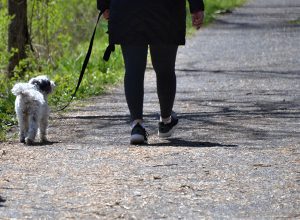Ok, by now we’re all experienced quarantiners. We wear masks, stand 6-feet apart, and work from home via the all-consuming—and mixed blessing—video conference. Don’t just zoom from your desk chair, get moving around the house, neighborhood, park, or trail…all while maintaining a smart social distance.
The U.S. Department of Health and Human Services stresses that we should all stay active. They address ways to stay active while social distancing by reminding us that “physical activity can help to boost your mood, reduce stress, improve sleep, and sharpen your focus—benefits that can be especially important during stressful times. Physical activity can also help you live a longer, healthier life by reducing the risk of many common chronic diseases, like type 2 diabetes and some cancers.”
Ideally, we’d all follow the recommended guidelines of 150 minutes of aerobic exercise and two days of muscle-strengthening exercise per week. But, they admit, “During stressful times, it’s important to remember that some physical activity is better than none! Adults should move more and sit less throughout the day. If you’re working from home, try taking activity breaks throughout the day or walking around your house during conference calls.”
While the Washington State Coronavirus Response officials agree that “staying home is still safest,” counties in Phase 2 and beyond can enjoy outdoor recreation in small, socially-distanced groups, while wearing a mask or face covering.
As the doctors from Health and Human Services agree “Going for a walk, run, or bike ride in your neighborhood can be a good way to get active, as long as you can safely maintain distance between yourself and other active neighbors…If you can’t practice safe social distancing outdoors, stay home and find ways to get active indoors. If you have to go outside near other people—like to walk your dog—wear a cloth face covering. If you have a yard, gardening and yardwork are also great ways to stay active and count toward meeting the Physical Activity Guidelines.”
Outdoors
 Restless? Try organizing a hike with family or friends. Exploring trails is better than window shopping downtown because it allows everyone to go their own pace and keep well apart. Pack snacks and coffee to make it a fun afternoon or all-day excursion.
Restless? Try organizing a hike with family or friends. Exploring trails is better than window shopping downtown because it allows everyone to go their own pace and keep well apart. Pack snacks and coffee to make it a fun afternoon or all-day excursion.
Live in a family-friendly neighborhood? Organize, and then explore, on a neighborly scavenger hunt. Some regions put teddy bears in silly spots, while others decorate window and door glass with inspirational pictures, rainbows, and cheerful thoughts in chalk or washable paint. These are great daily walks with or without kids and your family can participate in creative ways too.
Indoors
No, you don’t have to invest in expensive machines or equipment to exercise at home. The National Academy of Sports Medicine offers a 9-exercise workout plan that requires nothing more than time and willingness.
 Have an injury, disability, or limited range of motion? No problem. The National Center for Health, Physical Activity and Disability offers online videos of home workouts for everyone and even a series on meditation and mindfulness for those cabin fever-type days.
Have an injury, disability, or limited range of motion? No problem. The National Center for Health, Physical Activity and Disability offers online videos of home workouts for everyone and even a series on meditation and mindfulness for those cabin fever-type days.
There are even exercise websites like Fitness Blender that let you customize your workout based on duration, calorie goals, difficulty level, body focus, equipment, and training type. Have an old jump rope, medicine ball, or exercise band from previous New Year’s resolutions? They’ll work it in and provide hundreds of free options.
And don’t forget: All that organizing of closets, deep cleaning baseboards, and bagging up ancient holiday ornaments in the basement counts. Just keep moving as often as possible. Stuck in meetings all day? Standing up or wander the house. Headphone cord tie you to the computer? Bend and stretch when you can and make sure to take movement breaks in between calls. You don’t have to be wearing sneakers and spandex for it to count as exercise. Anything and everything counts.
—
Quarantine brain fog is a real thing. Scientists explain that “There is no end in sight to the fear of an invisible virus that might cause us to become sick or to lose a loved one. Additional worries about money, jobs, food, and housing—basic essentials to our very well-being—may be constant companions. Every day seems to bring bad news and questions that cannot be answered…We may make errors in decision-making or become stuck in old thought patterns. Brain fog creeps in quietly and insidiously.” But there’s one thing that helps clear the head, unclench muscles, relieve stress, and recharge the spirit: exercise. Get outside (if and when you can) and get moving.



